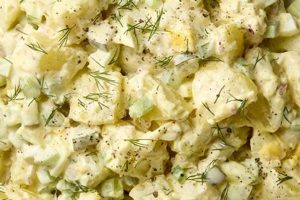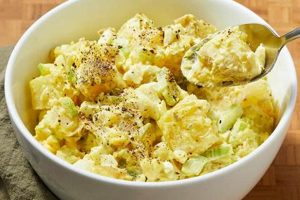A classic side dish featuring potatoes as the primary ingredient, this variation incorporates the tangy flavor of mustard and the richness of eggs. Typically, boiled potatoes are combined with a dressing of mustard, mayonnaise, and often other seasonings like celery seed, onion, or dill. Hard-boiled eggs, chopped or sliced, are added for protein and texture. This dish can be served warm, at room temperature, or chilled, making it a versatile option for picnics, potlucks, and barbecues.
This combination of ingredients offers a balance of creamy, tangy, and savory flavors. The simplicity of the ingredients makes it an economical and accessible dish, adaptable to various dietary preferences by substituting ingredients or adjusting seasonings. Its versatility allows it to complement a wide range of main courses, from grilled meats to fried fish. Variations exist across different cultures and families, showcasing the adaptability of this basic recipe.
The following sections will explore different approaches to preparing this dish, including variations in mustard types, potato choices, and additional ingredients to enhance flavor and presentation. Specific recipes will be provided, alongside tips and techniques for achieving optimal results.
Tips for an Exceptional Potato Salad
Achieving a perfect potato salad involves attention to detail in ingredient selection and preparation techniques. The following tips offer guidance for creating a flavorful and well-balanced dish.
Tip 1: Potato Selection: Opting for waxy potatoes, such as red or Yukon Gold, ensures they hold their shape after boiling and contribute a creamy texture. Russet potatoes, being starchier, tend to crumble.
Tip 2: Cooking Potatoes: Potatoes should be cooked until tender but not mushy. Overcooked potatoes will result in a less appealing texture. Starting potatoes in cold, salted water promotes even cooking.
Tip 3: Mustard Choice: Experimenting with different mustard varieties, such as Dijon, yellow, or whole grain, can significantly impact flavor profiles. Consider blending mustards to achieve complexity.
Tip 4: Dressing Consistency: The dressing should coat the potatoes without being overly runny. Gradual addition of mayonnaise and other liquids allows for adjustment to the desired consistency.
Tip 5: Egg Preparation: Properly cooked eggs, with firm yolks, enhance the visual appeal and texture of the salad. Cooling eggs quickly in ice water after boiling prevents the formation of a greenish ring around the yolk.
Tip 6: Chilling Time: Allowing the salad to chill for at least an hour allows the flavors to meld and enhances the overall experience. However, excessively long chilling periods can dry out the potatoes.
Tip 7: Fresh Herbs: Incorporating fresh herbs, such as dill, chives, or parsley, adds brightness and a fresh element to the final dish.
By following these guidelines, one can create a potato salad that is both visually appealing and flavorful. Attention to these details elevates the dish from simple to exceptional.
The following section offers specific recipe variations, allowing for personalized customization and exploration of diverse flavor combinations.
1. Potato Variety
Potato selection significantly influences the texture and overall success of mustard potato salad. Different potato varieties possess varying starch content and moisture levels, impacting their behavior when boiled and subsequently incorporated into the salad. Choosing the correct potato ensures a desirable final product, avoiding pitfalls like mushiness or excessive firmness.
- Waxy Potatoes (e.g., Red Bliss, New Potatoes, Fingerlings)
Characterized by lower starch content and higher moisture, waxy potatoes hold their shape well after cooking. This characteristic makes them ideal for potato salad, as they resist crumbling and maintain a firm, pleasant texture when mixed with the dressing. Their creamy consistency complements the tangy mustard and other ingredients.
- All-Purpose Potatoes (e.g., Yukon Gold)
Offering a balance between waxy and starchy properties, Yukon Golds provide a versatile option. They retain their shape reasonably well while offering a slightly softer texture compared to waxy varieties. This balance allows them to absorb some of the dressing while still maintaining structural integrity.
- Starchy Potatoes (e.g., Russet, Idaho)
High in starch and low in moisture, starchy potatoes tend to break down when boiled. This characteristic makes them less suitable for potato salad, as they can become mushy and absorb excessive amounts of dressing, leading to a less appealing final product. They are better suited for applications like mashed potatoes or baking.
- Impact on Flavor Absorption
The potato’s texture also affects how it absorbs the flavors of the dressing. Waxy potatoes, with their tighter structure, absorb less dressing, allowing the individual potato flavor to shine through. Starchy potatoes, on the other hand, absorb more dressing, leading to a more pronounced mustard flavor but potentially masking the potato itself.
Careful consideration of potato variety ensures the desired textural and flavor balance in the final mustard potato salad. Selecting waxy or all-purpose potatoes contributes to a cohesive, flavorful, and visually appealing dish, avoiding the pitfalls of a mushy or overly dry salad. The interplay between potato variety and dressing absorption ultimately dictates the overall culinary experience.
2. Mustard Selection
Mustard serves as a pivotal flavor component in mustard potato salad, contributing significantly to its characteristic tang and complexity. The choice of mustard variety influences not only the overall taste but also the texture and balance of the dish. Careful selection from the array of available mustards is crucial for achieving the desired flavor profile.
- Prepared Yellow Mustard
This widely available, mild mustard provides a familiar base flavor. Its smooth texture blends seamlessly into the dressing, offering a balanced tang without overpowering other ingredients. While versatile, its mildness may require additional seasonings to achieve a more pronounced flavor profile.
- Dijon Mustard
Originating from Dijon, France, this mustard offers a sharper, more complex flavor compared to yellow mustard. Its nuanced taste, derived from brown mustard seeds and white wine, adds depth to the salad. Dijon mustard’s creamy texture contributes to a richer dressing.
- Stone-Ground Mustard
Characterized by a coarse texture and robust flavor, stone-ground mustard adds a textural element in addition to its pungent taste. The visible mustard seeds within the dressing provide visual interest and a burst of flavor with each bite. This variety pairs well with bolder flavors in the salad.
- Honey Mustard
Blending the tang of mustard with the sweetness of honey, this variety introduces a contrasting flavor dimension. Honey mustard adds a touch of sweetness and complexity, balancing the savory elements of the potato salad. This option caters to those who prefer a milder, sweeter profile.
The interplay between mustard variety and other ingredients, such as potatoes, eggs, and seasonings, determines the final flavor profile of the salad. A thoughtful approach to mustard selection allows for customization and the creation of a dish that balances tang, sweetness, and savory notes according to individual preferences. Selecting the appropriate mustard elevates the potato salad from simple to nuanced and flavorful, enhancing the overall culinary experience.
3. Egg Preparation
Proper egg preparation is essential for both the aesthetic and textural appeal of mustard potato salad. The egg’s contribution extends beyond flavor, impacting the overall sensory experience. Careful consideration of cooking methods and timing ensures optimal results, enhancing the dish’s visual and textural complexity.
- Cooking Method
Hard-boiling is the standard method for eggs in potato salad. Achieving a firm yet creamy yolk is crucial. Overcooking results in dry, crumbly yolks and an unpleasant sulfurous odor, while undercooking yields runny yolks that disrupt the salad’s texture and appearance. Precise timing and controlled cooling prevent these undesirable outcomes.
- Timing
Cooking time directly influences yolk texture. A cooking time of 8-10 minutes typically yields a firm yet moist yolk. Variations in stovetop heat and altitude may necessitate adjustments. Visual cues, such as a fully set white and a light yellow yolk, indicate doneness.
- Cooling and Peeling
Immediately transferring cooked eggs to an ice bath halts the cooking process and facilitates easier peeling. Gentle tapping and rolling the egg on a flat surface creates cracks in the shell, allowing for efficient removal without damaging the egg white. A clean, smooth egg white enhances the salad’s visual appeal.
- Chopping vs. Slicing
The method of incorporating the egg into the salad impacts both texture and visual presentation. Chopping creates smaller pieces, distributing the egg evenly throughout the salad. Slicing, conversely, offers larger pieces, providing a more distinct egg presence in each bite. The chosen method influences the perceived texture and visual appeal of the finished dish.
The interplay of these egg preparation techniques contributes significantly to the overall success of mustard potato salad. A properly cooked, cooled, peeled, and incorporated egg enhances the dish’s visual appeal, textural complexity, and flavor balance. Attention to these details elevates the potato salad from simple to refined, showcasing the importance of egg preparation within the broader recipe.
4. Seasoning Balance
Seasoning balance is paramount in a successful mustard potato salad recipe with egg. This dish, characterized by the tang of mustard and richness of egg, requires careful calibration of seasonings to achieve a harmonious flavor profile. An imbalance can lead to a dish that is overly tangy, bland, or otherwise unappetizing. The interplay between salt, pepper, acidity, and other complementary spices determines the overall culinary experience. For instance, the inherent sharpness of mustard necessitates a balancing element of sweetness or acidity. This can be achieved through the addition of sweet pickle relish, a touch of sugar, or a splash of vinegar. The fattiness of mayonnaise, often used in the dressing, further necessitates careful salt adjustment to avoid blandness.
Specific spices play crucial roles in enhancing complexity. Celery seed, with its slightly bitter and earthy notes, complements the other flavors without overpowering them. Dill, fresh or dried, adds a bright, herbaceous element that cuts through the richness of the eggs and mayonnaise. Onion, whether finely chopped or granulated, provides a pungent bite that contrasts with the creamy texture of the potatoes. However, the quantity of each spice must be judiciously considered. Too much celery seed can create bitterness, while excessive dill can overwhelm the other delicate flavors. The goal is to create a symphony of flavors where each component complements the others without dominating the palate. Achieving this balance requires an understanding of individual spice profiles and their interaction within the overall composition of the salad.
Mastering seasoning balance elevates mustard potato salad with egg from a simple side dish to a culinary delight. It transforms a collection of ingredients into a cohesive whole, where each element contributes to a complex and satisfying flavor profile. Understanding the interplay of salt, acidity, and spices allows for nuanced adjustments tailored to individual preferences, ultimately resulting in a well-balanced and memorable culinary experience.
5. Chilling Time
Chilling time plays a crucial role in the final quality of mustard potato salad with egg. It is not merely a matter of food safety but a critical step that significantly influences flavor development and textural cohesion. The duration of chilling impacts the balance of flavors and the integration of the various components, ultimately affecting the overall sensory experience.
- Flavor Melding
Chilling allows the diverse flavors of the saladthe tang of mustard, the richness of the egg, the earthiness of the potatoes, and the nuances of other seasoningsto meld and harmonize. The flavors deepen and integrate, creating a more complex and balanced profile compared to a freshly made salad. This melding process intensifies over time, reaching an optimal point where the individual components contribute to a unified whole.
- Texture Enhancement
Chilling firms the potatoes, enhancing their textural integrity within the salad. This is particularly important if waxy potatoes are not used, as chilling helps them hold their shape and prevents excessive absorption of the dressing. The cooling process also allows the dressing to thicken slightly, further contributing to a more desirable texture.
- Optimal Chilling Period
While chilling enhances flavor and texture, excessive chilling can have detrimental effects. Overly long refrigeration can dry out the potatoes, leading to a less palatable texture. A chilling period of 1-4 hours is generally recommended to achieve optimal flavor melding and textural enhancement without compromising the quality of the ingredients. This timeframe allows sufficient time for flavor development while preventing undesirable textural changes.
- Serving Temperature Considerations
While thorough chilling is essential for flavor development, serving temperature also influences the sensory experience. Serving the salad directly from the refrigerator can mute some of the more delicate flavors. Allowing the salad to sit at room temperature for a short period before serving allows the flavors to express themselves more fully, enhancing the overall enjoyment of the dish.
The chilling process acts as a final, crucial step in creating a well-balanced and flavorful mustard potato salad with egg. It is a testament to the fact that time itself plays a significant role in culinary processes, transforming individual ingredients into a cohesive and delightful dish. The careful consideration of chilling time ensures that the final product delivers the optimal combination of flavor, texture, and overall culinary satisfaction.
Frequently Asked Questions
This section addresses common inquiries regarding the preparation and variations of mustard potato salad with egg, offering concise and informative responses to facilitate a deeper understanding of the dish.
Question 1: What type of potatoes are best suited for this salad?
Waxy potatoes, such as red bliss or Yukon Gold, are preferred due to their ability to hold their shape after boiling. Starchy potatoes tend to become mushy and are less suitable.
Question 2: Can different types of mustard be used?
Variations in mustard type, such as Dijon, stone-ground, or yellow mustard, offer unique flavor profiles. Experimentation is encouraged to discover preferred combinations.
Question 3: How can one prevent hard-boiled eggs from becoming overcooked?
Precise timing and immediate cooling in ice water after boiling prevent overcooking. A cooking time of 8-10 minutes generally yields ideal results.
Question 4: What can be added to enhance the flavor profile?
Fresh herbs like dill or chives, chopped celery, red onion, or sweet pickle relish can enhance flavor complexity and add textural interest.
Question 5: How long should the salad be chilled before serving?
Chilling for at least one hour allows flavors to meld. However, excessive chilling can dry the potatoes. A chilling period of 1-4 hours is generally recommended.
Question 6: Can this salad be prepared in advance?
Yes, it can be prepared a day in advance and stored in a refrigerator. Adding the eggs shortly before serving is recommended to maintain optimal texture and prevent discoloration.
Addressing these frequently asked questions offers a comprehensive understanding of crucial aspects related to crafting a successful mustard potato salad with egg. These insights should assist in achieving a balanced and flavorful dish tailored to individual preferences.
The following section will delve into specific recipe variations, offering detailed instructions for creating this classic side dish.
Conclusion
This exploration of mustard potato salad with egg has highlighted the multifaceted nature of this seemingly simple dish. From the careful selection of potato variety and mustard type to the precise preparation of eggs and the delicate balance of seasonings, each element contributes significantly to the final product. The importance of chilling time in melding flavors and enhancing texture further underscores the attention to detail required for a truly exceptional culinary experience. Variations in ingredients and techniques offer a wide spectrum of flavor profiles, demonstrating the adaptability of this classic dish.
Ultimately, the success of mustard potato salad with egg lies in the thoughtful combination of quality ingredients and meticulous execution. This dish, often relegated to the realm of the ordinary, possesses the potential for extraordinary culinary expression. An understanding of the underlying principles and attention to detail elevates this humble side dish to a position of deserved prominence on any table.






